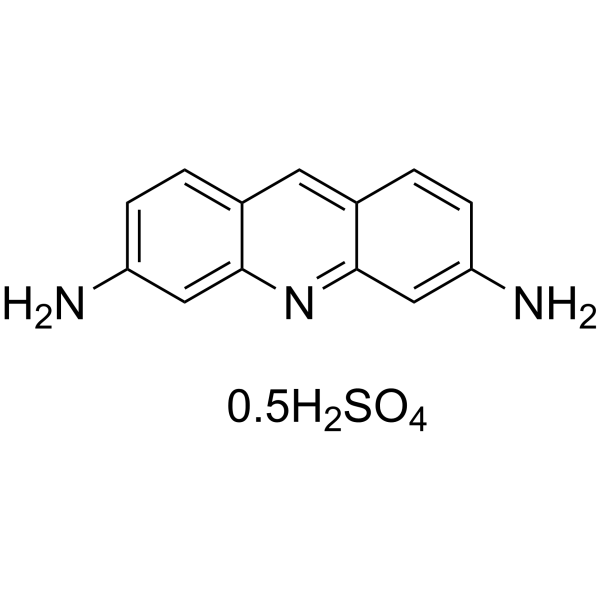Proflavine hemisulfate;(Synonyms: Proflavin hemisulfate; 3,6-Diaminoacridine hemisulfate) 纯度: 98.17%
Proflavine hemisulfate 是一种吖啶染料,也是一种 DNA嵌入剂。可用作抗菌剂 (Anti-microbial)。Proflavine hemisulfate 可作为 Kir3.2 孔阻滞剂。Proflavine hemisulfate 可用于研究与 Kir3.2 相关的神经系统疾病。

Proflavine hemisulfate Chemical Structure
CAS No. : 1811-28-5
| 规格 | 价格 | 是否有货 | 数量 |
|---|---|---|---|
| 10;mM;*;1 mL in Water | ¥550 | In-stock | |
| 100 mg | ¥500 | In-stock | |
| 200 mg | ; | 询价 | ; |
| 500 mg | ; | 询价 | ; |
* Please select Quantity before adding items.
Proflavine hemisulfate 相关产品
bull;相关化合物库:
- Membrane Transporter/Ion Channel Compound Library
- Clinical Compound Library
- Autophagy Compound Library
- Drug Repurposing Compound Library
- Antibacterial Compound Library
- Anti-COVID-19 Compound Library
- FDA Approved amp; Pharmacopeial Drug Library
- Anti-Alzheimer’s Disease Compound Library
- Neurodegenerative Disease-related Compound Library
- Drug Repurposing Compound Library Plus
- Clinical Compound Library Plus
- Bioactive Compound Library Plus
- Anti-Infection Compound Library
| 生物活性 |
Proflavine hemisulfate, an acridine dye, is a known DNA intercalating agent. Anti-microbial agent[1]. Proflavine hemisulfate behaves as a pore blocker for Kir3.2. Proflavine hemisulfate is a potential lead compound for Kir3.2-associated neurological diseases[2]. |
||||||||||||||||
|---|---|---|---|---|---|---|---|---|---|---|---|---|---|---|---|---|---|
| 体外研究 (In Vitro) |
Proflavine (0.1-10 μM; 24 hours) inhibits the growth of Kir3.2-transformant cells and Kir3.2 activity in a concentration-dependent manner[1]. MCE has not independently confirmed the accuracy of these methods. They are for reference only. Cell Viability Assay[2]
|
||||||||||||||||
| 体内研究 (In Vivo) |
The concentrations of Proflavine (20 mg/kg) in whole blood after intravenous injection decreased rapidly at the beginning and remained stable from around 30 min after dosing[3]. MCE has not independently confirmed the accuracy of these methods. They are for reference only.
|
||||||||||||||||
| Clinical Trial |
|
||||||||||||||||
| 分子量 |
258.29 |
||||||||||||||||
| Formula |
C13H12N3O2S0.5 |
||||||||||||||||
| CAS 号 |
1811-28-5 |
||||||||||||||||
| 中文名称 |
硫酸原黄素 |
||||||||||||||||
| 运输条件 |
Room temperature in continental US; may vary elsewhere. |
||||||||||||||||
| 储存方式 |
4deg;C, sealed storage, away from moisture *In solvent : -80deg;C, 6 months; -20deg;C, 1 month (sealed storage, away from moisture) |
||||||||||||||||
| 溶解性数据 |
In Vitro:;
H2O : ≥ 5 mg/mL (19.36 mM) * “≥” means soluble, but saturation unknown. 配制储备液
*
请根据产品在不同溶剂中的溶解度选择合适的溶剂配制储备液;一旦配成溶液,请分装保存,避免反复冻融造成的产品失效。 |
||||||||||||||||
| 参考文献 |
|
